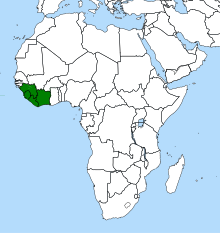| Triphyophyllum | |
|---|---|

| |
| Climbing adult Triphyophyllum with hooked leaves | |
| Scientific classification | |
| Kingdom: | Plantae |
| Clade: | Tracheophytes |
| Clade: | Angiosperms |
| Clade: | Eudicots |
| Order: | Caryophyllales |
| Family: | Dioncophyllaceae |
| Genus: | Triphyophyllum Airy Shaw (1951 publ. 1952) |
| Species: | T. peltatum |
| Binomial name | |
| Triphyophyllum peltatum (Hutch. & Dalziel) Airy Shaw (1952) | |

| |
| Triphyophyllum distribution | |
| Synonyms | |
| |
Triphyophyllum /ˌtrɪfioʊˈfɪləm/ is a monotypic plant genus, containing the single species Triphyophyllum peltatum of the family Dioncophyllaceae. It is native to tropical western Africa, in Ivory Coast, Sierra Leone and Liberia, growing in tropical forests.
It is a liana, with a three-stage lifecycle, each with a different shaped leaf, as indicated by its Greek name. In the first stage, T. peltatum forms a rosette of simple lanceolate leaves with undulate margins. At times when there is insufficient phosphorus in the soil it develops long, slender, glandular leaves, resembling those of the related Drosophyllum, which capture insects; one to three of these leaves in each rosette. In the plant's adult liana form it has short non-carnivorous leaves bearing a pair of "grappling hooks" at their tips on a long twining stem which can become 165 feet (50 meters) in length and four inches (10 cm) thick. T. peltatum is the largest of all confirmed carnivorous plants in the world, but its carnivorous nature did not become known until 1979, some 51 years after the plant's discovery. Its seeds are about 3 inches (7.6 cm) in diameter, bright red in color, disc-shaped, with a peltate stalk emerging from the fruit. Most of the seed's development occurs outside the fruit. The fruit and seed develop from an orange flower with five incurved petals. As the seed dries out, its wide umbrella shape enables it to be transported on the wind.
Triphyophylum peltatum is difficult to cultivate; it is cultivated in four botanical gardens: Abidjan, Bonn, Cambridge University and Würzburg, and is exceedingly rare in private collections.



Uses
Triphyophyllum peltatum is traditionally used in folk medicine. It produces many pharmaceutically active secondary metabolites, some of which have been found to have strong antiplasmodial activity. Some metabolites were found to have antitumoral and anti-multiple myeloma activity.
-
 Triphyophyllum compounds; top left: R = -H: Habropetalin A; R = -OH: Dioncophyllin A.; bottom left: Dioncophyllin; bottom right: Dioncophyllin C.
Triphyophyllum compounds; top left: R = -H: Habropetalin A; R = -OH: Dioncophyllin A.; bottom left: Dioncophyllin; bottom right: Dioncophyllin C.
References
- ^ Winkelmann, Traud; Bringmann, Gerhard; Herwig, Anne; Hedrich, Rainer (2023). "Carnivory on demand: phosphorus deficiency induces glandular leaves in the African liana Triphyophyllum peltatum". New Phytologist. 239 (3): 1140–1152. doi:10.1111/nph.18960. ISSN 0028-646X. PMID 37191044.
confirmation of phosphorus starvation to be essential and sufficient
- Simons, Paul (17 April 2024). "Plantwatch: why does a rainforest vine turn into a part-time carnivore?". The Guardian.
- "Triphyophyllum peltatum - Redfern Natural History". www.redfernnaturalhistory.com. Archived from the original on 2017-03-19.
- "Image of Triphyophyllum leaves". Archived from the original on 2018-02-16.
- George Cheer, A GUIDE TO CARNIVOROUS PLANTS OF THE WORLD (Pymble, New South Wales, Aust.: Angus and Robertson, 1992) p. 122.
- Sally Green et al, "Seasonal Heterophylly and Leaf Gland Features in Triphyophyllum (Dioncophyllaceae)", BOT. JOURNAL LINNEAN SOC. LONDON Vol. 78 # 2 (February 1979) pp. 99-116.
- John Hutchinson and J. M. Dalziel, "Tropical African Plants II" KEW BULLETIN (1928) pp. 31-32. (Under the name Dioncophyllum peltatum).
- "Triphyophyllum peltatum flower | floristtaxonomy.com". www.floristtaxonomy.com. Archived from the original on 2017-03-18.
- Bringmann, Gerhard; Schlauer, Jan; Wolf, Kristina; Rischer, Heiko; Buschbom, Uwe; Kreiner, Andreas; Thiele, Friedrich; Duschek, Martin; Assi, Laurent Ake (1999-03-01). "Cultivation of Triphyophyllum peltatum (Dioncophyllaceae), the part-time carnivorous plant". Carnivorous Plant Newsletter. 28 (1): 7–13. doi:10.55360/cpn281.gb418.
External links
- The Carnivorous Plant FAQ: About Triphyophyllum
- Bringmann, G., H. Rischer, J. Schlauer, K. Wolf, A. Kreiner, M. Duschek & L.A. Assi 2002. "The Tropical Liana Triphyophyllum peltatum (Dioncophyllaceae): Formation of Carnivorous Organs is only a facultative prerequisite for shoot elongation" (PDF). (1.30 MiB) Carnivorous Plant Newsletter 31(2): 44–52.
- Bringmann, G., J. Schlauer, K. Wolf, H. Rischer, U. Buschbom, A. Kreiner, F. Thiele, M. Duschek & L.A. Assi 1999. "Cultivation of Triphyophyllum peltatum (Dioncophyllaceae), the part-time carnivorous plant" (PDF). (1.25 MiB) Carnivorous Plant Newsletter 28(1): 7–13.
- Bringmann, G., M. Wenzel, H.P. Bringmann & J. Schlauer 2001. "Uptake of the amino acid alaninie by digestive leaves: proof of carnivory in the tropical liana Triphyophyllum peltatum (Dioncophyllaceae)" (PDF). (434 KiB) Carnivorous Plant Newsletter 30(1): 15–21.
- Jonathan 1992. "A letter from Sierra Leone" (PDF). (541 KiB) Carnivorous Plant Newsletter 21(3): 51–53.
- Rice, B. 2007. Carnivorous plants with hybrid trapping strategies. Carnivorous Plant Newsletter 36(1): 23–27.
- Simons, P. 1981. "How Exclusive are Carnivorous Plants?" (PDF). (1.10 MiB) Carnivorous Plant Newsletter 10(3): 65–68, 79–80.
| Carnivorous and protocarnivorous plants | |
|---|---|
| Carnivorous genera († extinct) |
|
| Protocarnivorous genera | |
| See also | |
| Taxon identifiers | |
|---|---|
| Triphyophyllum peltatum | |
| Dioncophyllum peltatum | |
This Caryophyllales article is a stub. You can help Misplaced Pages by expanding it. |